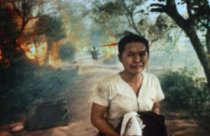
SOTALESKET
Yli kaksikymmentä vuotta myöhemmin hän lähti matkalle suruun, sodan perinteeseen, joka yltää maanosasta toiseen. Surulle kukaan ei ole sen enempää vihollinen kuin ystävä. Heinäkuusta 1957 toukokuuhun 1975 kestäneessä sodassa palveli 2,7 miljoonaa amerikkalaista, joista 58.000 kuoli, yli 300.000 haavoittui ja yli 2000 on ilmoitettu kadonneeksi.
Aloittaessaan projektiaan 1988 Barbara oli tavannut vain yhden muun amerikkalaisen sotalesken. Vaikka Vietnamin sodan veteraaneille perustettiin yhä uusia tukiryhmiä, jäivät lesket huomiotta
Parivuotisen työn tuloksena hän haastatteli yli 200 Vietnamin sodan leskeä nähden surua, joka jatkui vielä sodan päätyttyä. "Eräs nainen kertoi, miten hänen miehensä oli ampunut itsensä. Viestissä mies kertoi, ettei enää kestänyt takautumia", Barbara kertoo.
Barbara matkasi Vietnamiin kohdaten samaa surua. "Julmuus mitä koimme oli jokia pitempi, vuoria korkeampi, meriä syvempi", kuvaili yksi haastateltava. Jos ei ollut kuollut, ei ollut turvassa.
Barbara Sonnebornin elokuvassa Sotalesket (Regret to Inform) henkilökohtaiset muistot ovat globaali vetoomus rauhan puolesta. Se on myös syvästi koskettava todistus myötäelämisen parantavasta voimasta. "Haluan ihmisten katsovan sotaa kasvoihin kysyäkseen itseltään, sallinko tämän tapahtuvan enää koskaan", tiivistää Barbara Sonneborn dokumenttinsa sanoman.
- Ohjaaja: Barbara Sonneborn
- Tuotanto: Sun Foundation Productions, 1998
In English In English In English
REGRET TO INFORM
 In 1968, on her 24th birthday, Barbara Sonneborn received word that her husband, Jeff, had been killed in Vietnam while trying to rescue his wounded radio operator during a mortar attack. "We regret to inform," the telegram began. Twenty years later, Sonneborn, a photographer and visual artist, embarked on a journey in search of the truth about war and its legacy, eloquently chronicled in her debut documentary, Regret to Inform. Framed as an odyssey through Vietnam to Que Son, where Jeff was killed, Sonneborn weaves together the stories of widows from both sides of the American-Vietnam war. The result is a profoundly moving examination of the impact of war over time. The film is "so exquisitely filmed, edited and scored it is the documentary equivalent of a tragic epic poem," writes The New York Times. "Every word and image quivers with an anguished resonance."
In 1968, on her 24th birthday, Barbara Sonneborn received word that her husband, Jeff, had been killed in Vietnam while trying to rescue his wounded radio operator during a mortar attack. "We regret to inform," the telegram began. Twenty years later, Sonneborn, a photographer and visual artist, embarked on a journey in search of the truth about war and its legacy, eloquently chronicled in her debut documentary, Regret to Inform. Framed as an odyssey through Vietnam to Que Son, where Jeff was killed, Sonneborn weaves together the stories of widows from both sides of the American-Vietnam war. The result is a profoundly moving examination of the impact of war over time. The film is "so exquisitely filmed, edited and scored it is the documentary equivalent of a tragic epic poem," writes The New York Times. "Every word and image quivers with an anguished resonance."
In 1988, at the time Ms. Sonneborn began this project, she had met only one other American war widow. Despite the growing number of support groups that existed for Vietnam veterans, she was unaware of any support network for widows. Propelled by her desire to find other women who had experienced the same loss on both sides of the war, and to understand what could be learned about war through their stories, Ms. Sonneborn put together a production team in 1990 and sent out several thousand letters searching for widows in the US. The women were difficult to find.
In 1992, Sonneborn traveled to Vietnam, accompanied by Xuan Ngoc Nguyen, a South Vietnamese woman whose first husband was killed in the war fighting for South Vietnam. Xuan later married an American soldier and moved to the U.S. in the early 70's. She agreed to serve as Sonneborn's translator on the trip and to share her own story in the film. On their journey through Vietnam--where some 2 to 3 million people were killed during the war--they found women everywhere they went who wanted to be interviewed. Everybody had a story about loss and devastation from the war. "They were quite surprised and very moved that an American widow wanted to hear their stories," Sonneborn recalls. "The women recounted in painful detail the human and environmental damage caused by what they call 'the American war' in Vietnam." One woman in the film describes, "The cruelty we experienced was longer than a river, higher than a mountain, deeper than an ocean." Another adds, "If you weren't dead, you weren't safe."
"Making this film has been Jeff's gift to me," Sonneborn sums up. "It has expanded my understanding of sorrow and suffering, of love and joy. I want people to see war differently than they've seen it before. I want them to look war in the face, to ask themselves, 'Am I going to allow this to happen ever again?' I want people to so deeply realize the humanity of other human beings that they won't be able to kill them."
- Director: Barbara Sonneborn
- Production: Sun Foundation Productions, 1998

Päivitys: 15.4.2000 U.E.